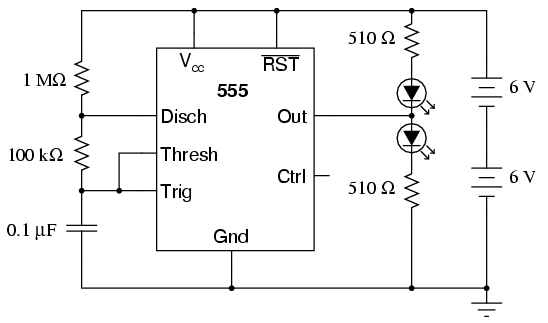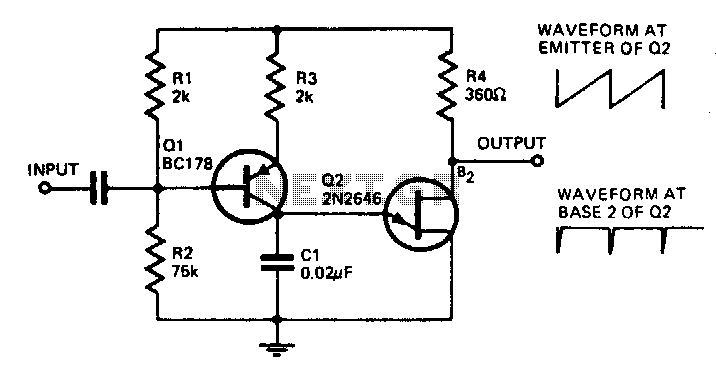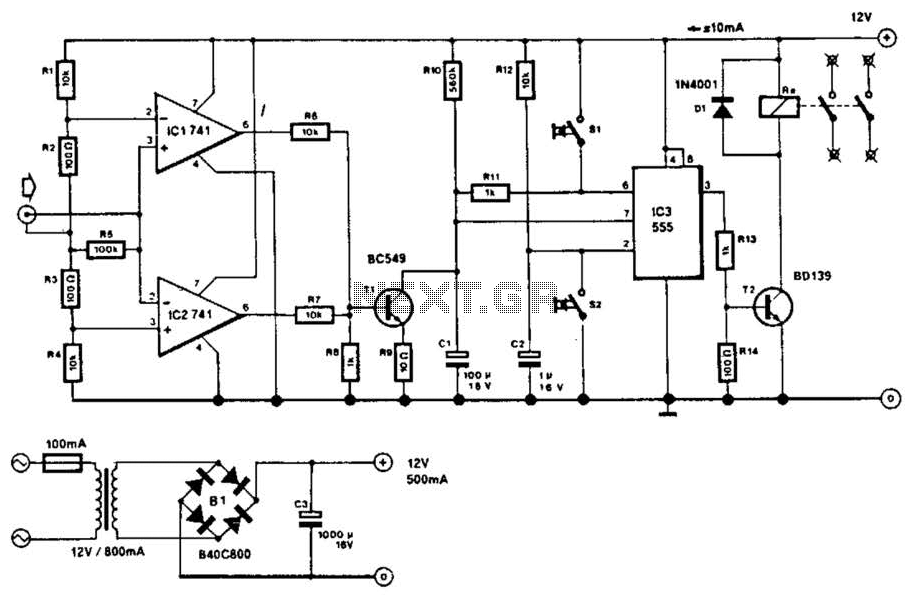
555 audio oscillator Analog Integrated Circuits

The 555 integrated circuit is a versatile timer that can be used for various applications. This experiment focuses on its operation as an astable multivibrator or oscillator. When connected to a capacitor and two resistors, it generates a square-wave output voltage that turns the LEDs on and off. The circuit operates by alternately charging and discharging the capacitor. The 555 timer discharges the capacitor by grounding the Discharge terminal when the voltage at the Threshold terminal exceeds two-thirds of the power supply voltage (Vcc). Discharging ceases when the voltage at the Trigger terminal drops below one-third of the power supply voltage. By connecting both the Threshold and Trigger terminals to the positive terminal of the capacitor, the voltage across the capacitor oscillates between one-third and two-thirds of the power supply voltage in a "sawtooth" waveform. During the charging phase, the capacitor receives current through a series combination of a 1 MΩ and a 100 kΩ resistor. When the Discharge terminal of the 555 timer goes to ground (activated by an internal transistor), the discharging current only flows through the 100 kΩ resistor. This configuration results in a longer RC time constant for charging compared to discharging, causing the charging time to significantly exceed the discharging time. The output terminal of the 555 timer generates a square-wave voltage signal that is "high" (close to Vcc) during the capacitor's charging phase and "low" (close to 0 volts) during the discharging phase. This alternating high and low voltage signal operates the two LEDs in opposite states: when one LED is illuminated, the other is off. Due to the unequal charging and discharging times of the capacitor, the "high" and "low" durations of the output square wave are also unequal. This difference can be observed in the brightness of the two LEDs, with one appearing much brighter as it remains lit for a longer duration in each cycle. The relationship between the "high" and "low" durations of a square wave is referred to as its duty cycle. A square wave with a 50% duty cycle is perfectly balanced, while one that is "high" for 10% of the time and "low" for 90% is said to have a 10% duty cycle. In this circuit, the output waveform has a longer "high" duration than "low," resulting in a duty cycle greater than 50%. An audio detector or oscilloscope can be used to analyze the various voltage waveforms produced by this circuit. Experimenting with different resistor and capacitor values can yield insights into their effects on output frequency and charge/discharge times.
The 555 timer IC is widely recognized for its reliability and ease of use in generating timing and oscillation functions in electronic circuits. In the astable multivibrator configuration, the circuit continuously switches between two states, making it ideal for applications like flashing LEDs, tone generation, and pulse-width modulation.
The circuit consists of three main components: the 555 timer IC, a capacitor (C), and two resistors (R1 and R2). The values of these resistors and the capacitor determine the frequency of oscillation and the duty cycle of the output signal. The charging and discharging paths through the resistors create a time delay that results in the LED blinking at a specific rate.
The capacitor charges through both resistors R1 and R2 when the output is high and discharges only through R2 when the output is low. This asymmetrical charging and discharging lead to a duty cycle that can be adjusted by varying the resistor values. The output frequency can be calculated using the formula:
\[ f = \frac{1.44}{(R1 + 2R2)C} \]
Where:
- \( f \) is the frequency of oscillation,
- \( R1 \) is the resistance in series with the capacitor,
- \( R2 \) is the resistance through which the capacitor discharges,
- \( C \) is the capacitance.
By selecting appropriate values for R1, R2, and C, one can tailor the frequency and duty cycle to suit specific applications. The duty cycle can be calculated as:
\[ Duty\ Cycle = \frac{R2}{R1 + 2R2} \times 100\% \]
This relationship allows for fine-tuning of the circuit for various applications, such as creating different flashing patterns for LEDs or generating specific audio tones. The 555 timer's versatility makes it a fundamental component in many electronic projects, providing a simple and effective solution for timing and oscillation needs.The 555 integrated circuit is a general-purpose timer useful for a variety of functions. In this experiment, we explore its use as an astable multivibrator, or oscillator. Connected to a capacitor and two resistors as shown, it will oscillate freely, driving the LEDs on and off with a square-wave output voltage. This circuit works on the princip le of alternately charging and discharging a capacitor. The 555 begins to discharge the capacitor by grounding the Disch terminal when the voltage detected by the Thresh terminal exceeds 2/3 the power supply voltage (Vcc). It stops discharging the capacitor when the voltage detected by the Trig terminal falls below 1/3 the power supply voltage.
Thus, when both Thresh and Trig terminals are connected to the capacitor`s positive terminal, the capacitor voltage will cycle between 1/3 and 2/3 power supply voltage in a "sawtooth" pattern. During the charging cycle, the capacitor receives charging current through the series combination of the 1 M © and 100 k © resistors.
As soon as the Disch terminal on the 555 timer goes to ground potential (a transistor inside the 555 connected between that terminal and ground turns on), the capacitor`s discharging current only has to go through the 100 k © resistor. The result is an RC time constant that is much longer for charging than for discharging, resulting in a charging time greatly exceeding the discharging time.
The 555`s Out terminal produces a square-wave voltage signal that is "high" (nearly Vcc) when the capacitor is charging, and "low" (nearly 0 volts) when the capacitor is discharging. This alternating high/low voltage signal drives the two LEDs in opposite modes: when one is on, the other will be off.
Because the capacitor`s charging and discharging times are unequal, the "high" and "low" times of the output`s square-wave waveform will be unequal as well. This can be seen in the relative brightness of the two LEDs: one will be much brighter than the other, because it is on for a longer period of time during each cycle.
The equality or inequality between "high" and "low" times of a square wave is expressed as that wave`s duty cycle. A square wave with a 50% duty cycle is perfectly symmetrical: its "high" time is precisely equal to its "low" time.
A square wave that is "high" 10% of the time and "low" 90% of the time is said to have a 10% duty cycle. In this circuit, the output waveform has a "high" time exceeding the "low" time, resulting in a duty cycle greater than 50%.
Use the audio detector (or an oscilloscope) to investigate the different voltage waveforms produced by this circuit. Try different resistor values and/or capacitor values to see what effects they have on output frequency or charge/discharge times.
🔗 External reference
The 555 timer IC is widely recognized for its reliability and ease of use in generating timing and oscillation functions in electronic circuits. In the astable multivibrator configuration, the circuit continuously switches between two states, making it ideal for applications like flashing LEDs, tone generation, and pulse-width modulation.
The circuit consists of three main components: the 555 timer IC, a capacitor (C), and two resistors (R1 and R2). The values of these resistors and the capacitor determine the frequency of oscillation and the duty cycle of the output signal. The charging and discharging paths through the resistors create a time delay that results in the LED blinking at a specific rate.
The capacitor charges through both resistors R1 and R2 when the output is high and discharges only through R2 when the output is low. This asymmetrical charging and discharging lead to a duty cycle that can be adjusted by varying the resistor values. The output frequency can be calculated using the formula:
\[ f = \frac{1.44}{(R1 + 2R2)C} \]
Where:
- \( f \) is the frequency of oscillation,
- \( R1 \) is the resistance in series with the capacitor,
- \( R2 \) is the resistance through which the capacitor discharges,
- \( C \) is the capacitance.
By selecting appropriate values for R1, R2, and C, one can tailor the frequency and duty cycle to suit specific applications. The duty cycle can be calculated as:
\[ Duty\ Cycle = \frac{R2}{R1 + 2R2} \times 100\% \]
This relationship allows for fine-tuning of the circuit for various applications, such as creating different flashing patterns for LEDs or generating specific audio tones. The 555 timer's versatility makes it a fundamental component in many electronic projects, providing a simple and effective solution for timing and oscillation needs.The 555 integrated circuit is a general-purpose timer useful for a variety of functions. In this experiment, we explore its use as an astable multivibrator, or oscillator. Connected to a capacitor and two resistors as shown, it will oscillate freely, driving the LEDs on and off with a square-wave output voltage. This circuit works on the princip le of alternately charging and discharging a capacitor. The 555 begins to discharge the capacitor by grounding the Disch terminal when the voltage detected by the Thresh terminal exceeds 2/3 the power supply voltage (Vcc). It stops discharging the capacitor when the voltage detected by the Trig terminal falls below 1/3 the power supply voltage.
Thus, when both Thresh and Trig terminals are connected to the capacitor`s positive terminal, the capacitor voltage will cycle between 1/3 and 2/3 power supply voltage in a "sawtooth" pattern. During the charging cycle, the capacitor receives charging current through the series combination of the 1 M © and 100 k © resistors.
As soon as the Disch terminal on the 555 timer goes to ground potential (a transistor inside the 555 connected between that terminal and ground turns on), the capacitor`s discharging current only has to go through the 100 k © resistor. The result is an RC time constant that is much longer for charging than for discharging, resulting in a charging time greatly exceeding the discharging time.
The 555`s Out terminal produces a square-wave voltage signal that is "high" (nearly Vcc) when the capacitor is charging, and "low" (nearly 0 volts) when the capacitor is discharging. This alternating high/low voltage signal drives the two LEDs in opposite modes: when one is on, the other will be off.
Because the capacitor`s charging and discharging times are unequal, the "high" and "low" times of the output`s square-wave waveform will be unequal as well. This can be seen in the relative brightness of the two LEDs: one will be much brighter than the other, because it is on for a longer period of time during each cycle.
The equality or inequality between "high" and "low" times of a square wave is expressed as that wave`s duty cycle. A square wave with a 50% duty cycle is perfectly symmetrical: its "high" time is precisely equal to its "low" time.
A square wave that is "high" 10% of the time and "low" 90% of the time is said to have a 10% duty cycle. In this circuit, the output waveform has a "high" time exceeding the "low" time, resulting in a duty cycle greater than 50%.
Use the audio detector (or an oscilloscope) to investigate the different voltage waveforms produced by this circuit. Try different resistor values and/or capacitor values to see what effects they have on output frequency or charge/discharge times.
🔗 External reference





